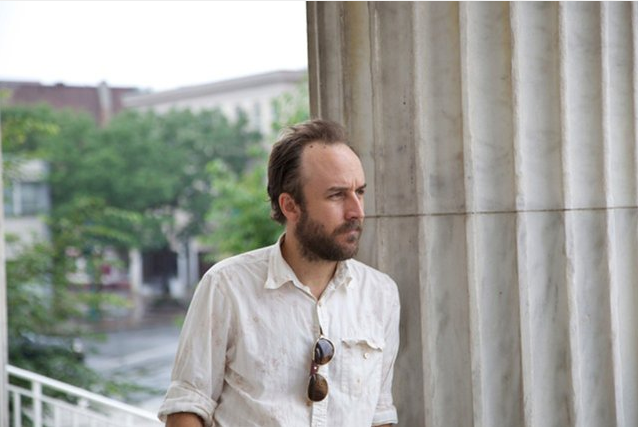Derek Cianfrance and the Sins of the Fathers

ABOVE: DEREK CIANFRANCE SHOOTING THE PLACE BEYOND THE PINES. IMAGE COURTESY OF ATSUSHI NISHIJIMA/FOCUS FEATURES
In his 1988 review of Sidney Lumet’s Running on Empty—a film about a family on the lam whose teenaged son (played by River Phoenix) must break away and choose his own path—Roger Ebert writes, “But it’s a funny thing about the past. The more you run from it, the more it’s in your thoughts.” Lumet characterizes that sentiment further in his book Making Movies, when he lays out the film’s key concern: “Who pays for the passions and commitments of the parents?” It’s a timeless tale, one that is being revisited by director Derek Cianfrance’s follow-up to Blue Valentine, in his sweeping part-saga, The Place Beyond the Pines.
Set in Schenectady, New York, the story unfolds in three parts. It begins with motorcycle stunt driver, Luke (played by Ryan Gosling), who, upon discovering he fathered an infant son, decides to rob banks in order to support his family. Tattooed and flaxen-haired, he is quintessential Gosling. One minute, he’s gripping a gun and threatening a bank teller; the next, he’s building his baby’s crib. He’s the strong and silent type who zips on his bike like a Spirograph in a Globe of Death, but who also serenades on doorsteps, smiles in pictures, and loves ice cream.
But Pines is also a story about Avery (Bradley Cooper), an ex-lawyer turned cop, who made a mistake years ago as a rookie. Avery’s guilt accrues and is eventually inherited in some form by his son. Echoing Lumet, Cianfrance has described Pines as being about legacy: “what we’re born with and what we pass on.” As in Blue Valentine, the director’s attraction to stories about family is palpable, and the last third of The Place Beyond the Pines, starring the father’s sons (standout performances by Dane DeHaan and Emory Cohen) is the film’s ballast.
DURGA CHEW-BOSE: Are you super talked out?
DEREK CIANFRANCE: No I’m okay. It’s a good problem to have, you know. When I made my student film, a feature, nobody wanted to talk to me and I was, like, in the desert for 12 years.
CHEW-BOSE: So there’s this one very brief image in the movie when Dane’s character is at the drugstore and is about to steal Oxy, as he ducks behind the display of greeting cards—there’s an out of focus, Father’s Day’s card beside his face on the screen. It felt like a very exacting moment of in the movie—since, after all, it’s about fathers and sons.
CIANFRANCE: You’re the first person that saw that, I’m so thankful that you noticed that. I think that when you make movies, you have to have little secrets all over it. It’s important.
CHEW-BOSE: After the screening, I was e-mailing with a friend, and we both agreed there was a Sidney Lumet quality to Pines—it has qualities of both Dog Day Afternoon and Running on Empty. So much so that I revisited Lumet’s book Making Movies, because I remembered a quote from it that applied to your movie perfectly—about the next generation paying for its parents’ “passions and commitments,” which is very much in line with Pines.
CIANFRANCE: Wow, yeah.
CHEW-BOSE: And just the scenes with River Phoenix on his bike and Dane DeHaan on his bike…
CIANFRANCE: You know, I have never seen that movie, but I have to go see it now. I’m gonna check it out. Look, he’s one of my favorite filmmakers. I feel like his approach to filmmaking was always so human. He was always making movies about the people. He wasn’t about the tricks, you know what I mean? From 12 Angry Men on. Another film of his which I really, really love is Prince of the City, with Treat Williams, which is kind of a lost classic. That character and that performance by Treat Williams is so great. [Lumet] is one of those film heroes that changed movies for everyone.
CHEW-BOSE: In terms of the way time elapses in Pines as oppose to Blue Valentine—here, the story is linear, whereas in Blue Valentine, you used flashbacks. There was an epic quality to Pines, and I wonder if some of that had to do with its linear nature and if you could speak a bit to why you decided to structure the film that way.
CIANFRANCE: I love crosscut parallel storytelling, [like we did] in Blue Valentine. I love how Iñárritu has done it, and Tarantino, and Coppola, and all the way back to D.W. Griffith—this parallel editing is an effective way to tell stories. It’s like juggling, like keeping a lot of balls in the air and seeing how they come down. But with Pines, to me the first choice and the bravest choice of the movie was to keep it linear, and it was one of the most crucial choices of the movie. There were people early on who called for it to be intercut, but that’s the thing—I’m so sick of seeing guns in movies, and all this violence; and if there was going to be violence in this movie, I wanted it to actually be narrative violence. I wasn’t interested in fetishizing violence in any way of making it feel cool or slow-motion violence. I wanted it to be just violence that affected the story. So you see all of this adrenaline and all these choices that lead up to this moment of violence, I wanted there to be the reverberation of this moment. It echoes in another generation. As an audience member, you then have to experience it as you would if it happened to you in your real life. There’s no sanctity of a flashback.
CHEW-BOSE: In this way, the movie felt more like a play, like a tragedy. Sometimes flashbacks can feel very manipulative.
CIANFRANCE: Yeah, I was thinking a lot about this idea of avoidance and how you try avoid things, and in trying to avoid things you end up running into them.
CHEW-BOSE: I read that you really don’t like editing.
CIANFRANCE: Yeah.
CHEW-BOSE: Is there a scene you had to cut that still really bothers you?
CIANFRANCE: I always say writing is like dreaming, shooting is like living, and editing is like murder, because you take all these gifts that actors give you, and you cut them. I’ve had to cut my mom out of a movie before—it’s ruthless, editing. But it’s also so necessary; because once you start taking away, it’s like sculpture, you can really start feeling the shape of the whole. And with Pines, there were all these scenes with Ryan and Ben Mendelson, there’s all these scenes where they were coming up with how they were going to split the take [from a bank robbery they conduct in tandem], and Ryan and Ben are both two very stubborn actors, so they start arguing, with Ryan saying he wants 90/10, and Ben saying he wants 50/50. So we had like nine minute takes of them not budging, but it’s the most entertaining—it’s the best footage, it’s hilarious. But I can’t have those minutes.
CHEW-BOSE: That sounds great, though.
CIANFRANCE: It is great. It’s going to go in the DVD bonus moments. [laughs]
CHEW-BOSE: So much of Pines is shot from behind the characters, following them out of the rooms, or into diners. Why was that a choice you continued to repeat throughout the film?
CIANFRANCE: From making documentaries all these years, it doesn’t feel right to lead someone. In narratives, I’m always trying to shoot as though it’s really happening, and I trust my actors are going to make decisions that I’m going to be following. I want to follow them. It feels dishonest to be pulling back in that opening shot and leading him to his destiny. Also, I want to get out of the way of the actors. I want to get out of their eye lines. I want to them to stop thinking they’re making a movie. I want them to just go and live. It’s like you take these great actors and put them in an aquarium of life, and just watch them swim. That’s what makes editing tough because you get all these beautiful, unplanned moments. My script alone was 158 pages, and the financier told me they would give me the money to make the movie if I got it under 120 pages. So I just shrank the font and extended the margins, and then no one knew!
THE PLACE BEYOND THE PINES IS OUT TOMORROW, MARCH 29.






